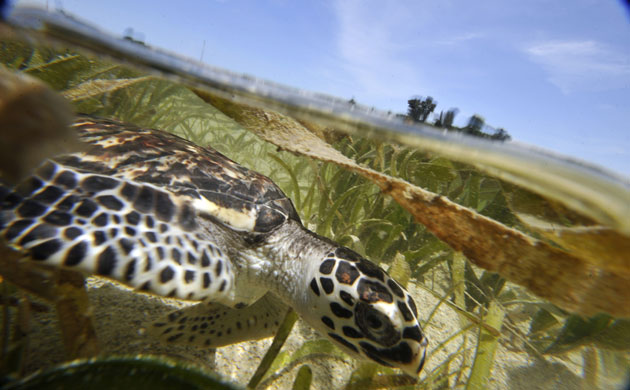TOP STORIES
The exact cause of the horrific burns inflicted on two Port River dolphins is unlikely to ever be known, despite a global search by local authorities.
. . . Dr Bossley, director of the Whale and Dolphin Conservation Society, said he was “more positive” about the dolphins likelihood of recovery, although the injuries were still a concern.
“We’ve had responses from researchers and veterinarians from all over the world and it was universally acknowledged as the the worst ever injuries seen on a surviving dolphin,” he said.
Portside Messenger - portside-messenger.whereilive.com.au [submitted by Australia Wildlife Health Network]
21 April 2010
H Kennett
Photo credit: B Saberton
21 April 2010
H Kennett
Photo credit: B Saberton
Viral Hemorrhagic Septicemia was first discovered in Lake Superior last December, joining the other Great Lakes that have had the virus for the past four or five years.
. . . VHS killed 30,000 freshwater drum fish in Lake Ontario in 2005 while several thousand round goby washed up on beaches in Lake Michigan two years ago. UW-Stevens Point Aquaculture Manager Greg Fischer doesn't think that'll happen in Lake Superior.
"It's tough for growing fish in Lake Superior because there is a lack of nutrients but on the flipside it may be saving Lake Superior because of that lack of nutrients."
91.3 KUWS - www.businessnorth.com/kuws
22 April 2010
M Simonson
22 April 2010
M Simonson
 Acidifying Oceans Dramatically Stunt Growth of Already Threatened Shellfish, Research Finds
Acidifying Oceans Dramatically Stunt Growth of Already Threatened Shellfish, Research FindsNew research shows that global warming and its effects -- in particular, ocean acidification -- have descended upon shellfish reefs, particularly those formed by the Olympia oyster.
Gaylord is investigating the consequences of this increasing ocean acidity on the growth of larval and juvenile Olympia oysters native to the U.S. West Coast.
"Such early life stages can be extremely sensitive to environmental stresses like ocean acidification," says Gaylord. "These stages operate as bottlenecks that drive overall population numbers. If larval and juvenile Olympia oysters decline as a result of an acidifying ocean, what does that mean for the species as a whole?"
Science Daily - www.sciencedaily.com
23 April 2010
23 April 2010
More Climate Change News
TOP READ LINKS FROM LAST WEEK
News
- Establishment of a northeast wildlife disease consortium - 66th Annual Northeast Fish and Wildlife Conference [conference abstract]
- Port River dolphins 'scalded'
- Severe pneumonia outbreak kills bighorn sheep
- Scientists: What's killing all the gray whales?
- Pictures: Strange Sea Species Found Off Greenland
- The week in wildlife [photo gallery]
- Bat die-off could have disastrous effect on ecology
- Scientists Say Tests Show Dangers in So-Called Bushmeat
- Australia stranding kills around 30 dolphins
- Federal agencies agree to help sage grouse in West
- Detection of the Abnormal Isoform of the Prion Protein Associated With Chronic Wasting Disease in the Optic Pathways of the Brain and Retina of Rocky Mountain Elk (Cervus elaphus nelsoni)
- Pathogenesis of Chronic Wasting Disease in Cervidized Transgenic Mice
- THE AUSTRALIAN REGISTRY OF WILDLIFE HEALTH - Newsletter of Interesting Cases [pdf]
OTHER WILDLIFE HEALTH RELATED NEWS
Photo credit: R Gacad/AFP/Getty Images
 The week in wildlife [image gallery]
The week in wildlife [image gallery]- Oil spill in Gulf could be devastating to dozens of endangered species
- State Investigators Prepare For Possible Fish Disease And Mortality Outbreaks [Virginia, USA]
- Standing Rock Game & Fish testing for chronic wasting disease
- Mammals are more effective invasive species than birds, study finds
Whale News
Rare Wildlife Sightings
- Huge Group of Rare Whales Off Vineyard
- Giant deep sea jellyfish filmed in Gulf of Mexico [includes video]
It Ain't All Bad News
- Endangered sturgeon fish flourishing in Wisconsin
- Lungless frog and 'ninja slug' among new species discovered under Borneo protection plan [includes image gallery]
Huh, That's Interesting!
- Bird Brain? Clever Crows Surprise With Innovative Tool Use [includes video]




